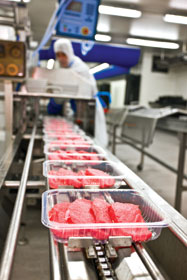

From food processing to petrochemical plants, to plastic injection moulding and many other industrial applications, pressure measurement is needed for the control of processes and machinery. The user is then often faced with the question: What pressure sensor should be used – a relative or an absolute type? This article presents the differences between the two types and their respective applications.
The main difference between relative and absolute pressure measurement is the implemented reference pressure, or in other words: the zero point of the scale. During relative pressure measurement, the pressure is always measured in relation to the current ambient pressure (‘relative’). A pressure sensor for absolute pressure measurement, on the other hand, always measures the pressure as a positive value with respect to the absolute zero point of pressure (absolute vacuum).
Measurement techniques
In order to measure relative or absolute pressure, a sensor must be capable of detecting a change in the pressure of a medium and comparing it with the reference pressure. Electronic pressure sensors usually measure the change in pressure through the deformation of a diaphragm. If this diaphragm is exposed to the process pressure on one side and ‘vented’ on the other (thus exposed to the ambient pressure), the deformation is reduced by exactly this ambient pressure. Therefore, the measuring result is a pressure difference in relation to the currently present ambient pressure.
In applications with high pressures (6000 bar) and at the same time a harsh set of working conditions, such as water jet cutting, ‘unvented’ pressure sensors are used, i.e. with the case sealed during manufacturing. Since, at such high pressure ranges, the fluctuations in ambient pressure compared with the process pressure are negligibly small, within 230 mbar, it is not important what the atmospheric pressure is and how reliably the case is sealed.
For absolute pressure sensors, the ‘internal’ (the part of the sensor not in contact with the pressure media) is evacuated and then permanently hermetically-sealed. Thus, the measured deformation of the diaphragm is independent of the ambient pressure and always refers to the enclosed vacuum.
Typical applications
It is recommended that the appropriate type of pressure sensor is used for each application. For example, in unpressurised vessels, where liquids are stored and where the tank is freely connected to the atmosphere above the liquid (and thus is ‘vented’), the current level can be measured as a derivation of the hydrostatic pressure of the liquid column using a similarly vented relative pressure sensor. Thus it is particularly important for smaller tanks and containers to eliminate the influence of the ambient pressure on the measurement through the common ventilation of sensor and vessel, otherwise, for a constant level of liquid, the calculated liquid level in the tank will fluctuate as a function of the ambient pressure. This variation may be up to 30 mbar due to the actual weather conditions and up to 200 mbar as a result of the location – pressure difference between sea level and 2000 m.
A level of 5 m of water in an open tank generates a hydrostatic pressure of 500 mbar. Thus, with an unchanging quantity of water, an absolute pressure sensor would indicate a fill level of between 4,7 and 5,3 metres, depending on the weather conditions. Since the fill volume is very often calculated from the tank geometry and the level measured, this may result in a substantial measurement error in the tank contents.
In other applications, such as water jet cutting, the influence of ambient pressure does not lead to a significant measurement error since the water jet reaches a process pressure of up to 6000 bar and a variable ambient pressure in the range of 230 mbar does not cause any large measurement inaccuracy. Due to the high risk of water ingress, it is recommended that a ‘non-vented’ case is used here so that there is no possibility of ingress of water or dirt through a vent.
Applications with lower pressure ranges that need, for example, a measurement of vacuum, require absolute pressure sensors for high accuracy. For example, in meat packing, a vacuum of a defined quality must be generated, so that a maximum shelf life can be safely ensured. The residual amount of oxygen in the packaging (i.e. the residual pressure relative to vacuum) is directly proportional to the shelf-life of the packaged food. A measurement uncertainty due to atmospheric changes of 30 mbar, at the usual residual pressure in the food packaging of 65 mbar, would lead to substantial fluctuations in the expiry date that could be guaranteed.
The applications described here are only a few select examples of the sometimes very different uses of the different pressure sensors and show that, in each case, the specific accuracy requirements and ambient conditions must be considered.
| Tel: | +27 11 621 0000 |
| Email: | [email protected] |
| www: | www.wika.co.za |
| Articles: | More information and articles about WIKA Instruments |

© Technews Publishing (Pty) Ltd | All Rights Reserved